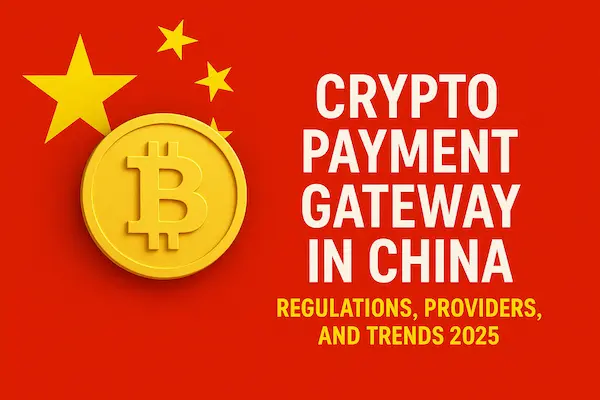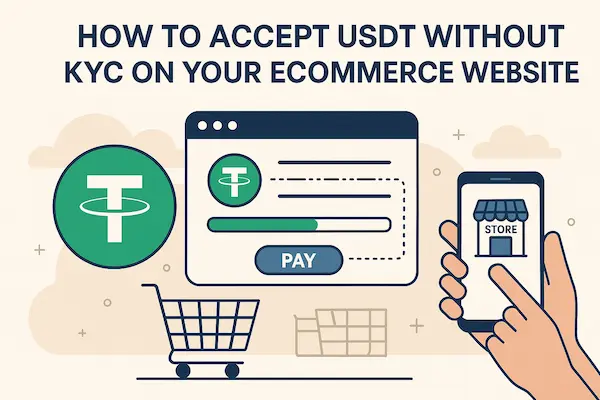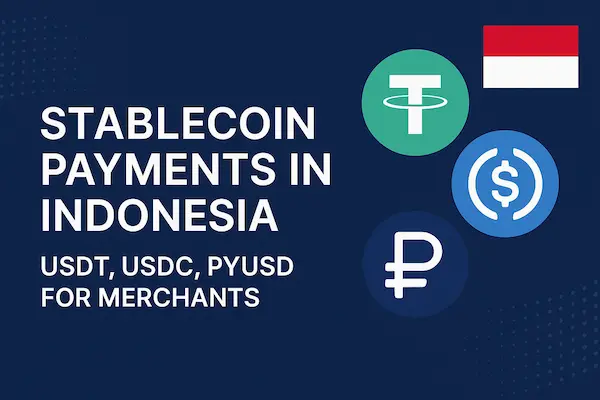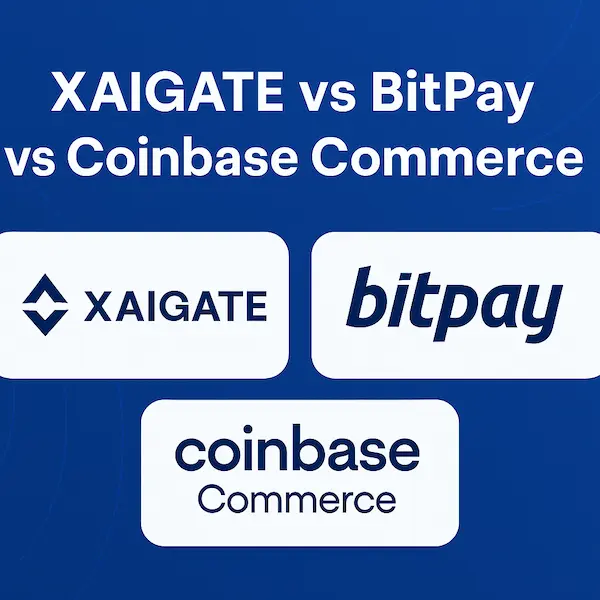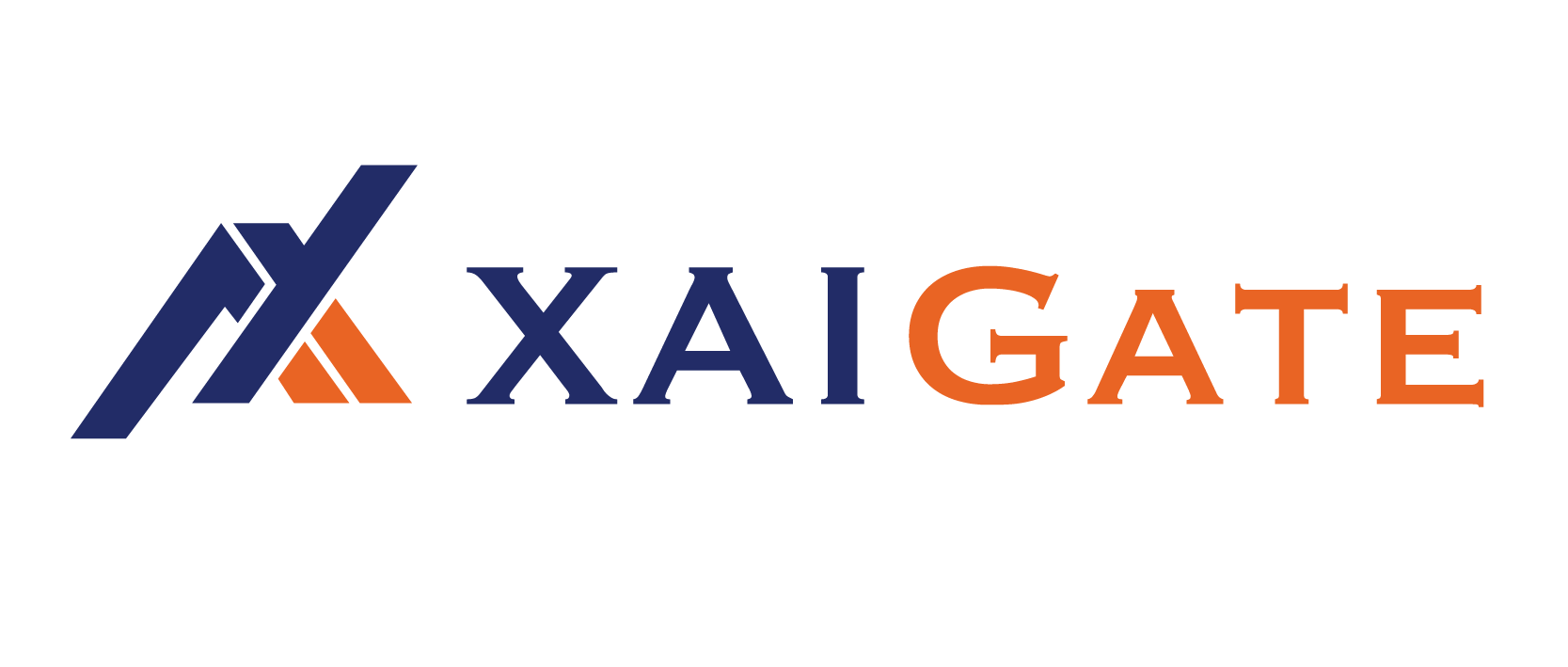Over the past decade, China has taken a cautious yet strategic approach to cryptocurrencies. While domestic trading and initial coin offerings (ICOs) remain prohibited, the rise of cross-border stablecoin payments and the development of the Digital Yuan (e-CNY) have opened new opportunities for merchants, exporters, and technology startups. In 2026, businesses that rely on international trade and eCommerce are increasingly exploring a crypto payment gateway in China as a cost-effective way to settle transactions beyond traditional banking rails.
According to the People’s Bank of China (PBoC), the e-CNY has already surpassed 1.8 trillion yuan (≈ $250 billion) in pilot transaction volume by late 2024. At the same time, global stablecoins like USDT and USDC continue to dominate cross-border settlements in Asia, accounting for over 70% of crypto transaction volume in the region (Chainalysis, 2024). These two forces—CBDCs and stablecoins—are shaping the competitive landscape for payment providers in China.
Contents
- 1 1. Regulations Governing Crypto Payment Gateway in China
- 2 2. Why Businesses Consider a Crypto Payment Gateway in China
- 3 3. Leading Crypto Payment Gateway Providers for China in 2026
- 4 4. Key Challenges for Crypto Payment Gateways in China
- 5 5. Step-by-Step: How Merchants Can Accept Crypto Payments from China
- 6 6. Case Studies: Real-World Applications of Crypto Payment Gateway in China
- 7 7. Future Outlook: How e-CNY and Stablecoins Will Shape Crypto Payment Gateway in China
- 8 FAQs about Crypto Payment Gateway in China
- 9 Conclusion: The Strategic Future of Crypto Payment Gateway in China
1. Regulations Governing Crypto Payment Gateway in China
China’s stance on cryptocurrencies has been well documented:
2017: ICO ban and closure of domestic exchanges.
2021: Nationwide crackdown on crypto mining and trading.
2023–2026: Shift toward supporting blockchain-based cross-border payments under strict regulatory frameworks.
While crypto payments within mainland China remain prohibited, cross-border transactions using blockchain and stablecoins are being tested under state-controlled sandboxes. For example, the mBridge project, a multi-CBDC pilot involving China, Hong Kong, Thailand, and the UAE, has already processed millions of dollars in trial settlements.
Comparison Table #1: Crypto Regulations in Asia (2026)
| Criteria | China 2026 | Singapore 2026 | Hong Kong 2026 |
|---|---|---|---|
| Domestic legality | Prohibited | Licensed under MAS | Licensed under SFC |
| Stablecoin use | Restricted, sandboxed | Fully regulated | Sandbox supported |
| CBDC adoption | e-CNY in pilot stage | N/A | e-HKD pilot |
| Cross-border | Allowed via sandbox | Free with compliance | Liberalized |
For businesses seeking a crypto payment gateway in China, the regulatory path is narrower than Singapore or Hong Kong, but the opportunity lies in cross-border settlement and integration with e-CNY.
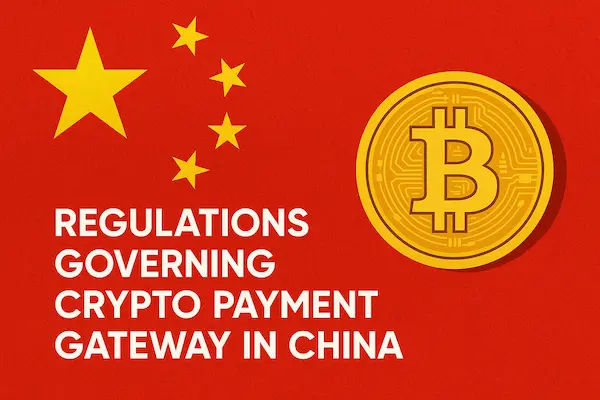
2. Why Businesses Consider a Crypto Payment Gateway in China
China’s role in global trade and eCommerce is expanding rapidly, yet traditional banking channels often create barriers due to high costs and long settlement times. To overcome these challenges, many companies are exploring the benefits of a crypto payment gateway in China. Below are the main reasons why adoption is growing.
1. Reducing Cross-Border Transaction Costs
International wire transfers usually come with multiple intermediary fees, sometimes totaling 3–6% per transaction. For SMEs exporting goods, this significantly reduces profitability. A crypto payment gateway allows merchants in China to settle transactions in USDT or USDC with costs as low as 0.5%, offering immediate savings that strengthen their competitiveness.
2. Accelerating Settlement Speed
Speed is critical in international business. Traditional wire transfers may take two to five business days, slowing down supply chains and cash flow. With a crypto payment gateway in China, payments can be finalized in minutes, helping exporters and service providers secure liquidity faster and maintain smoother business operations.
3. Expanding Access to International Customers
China’s cross-border eCommerce sector surpassed $260 billion in 2024. Many international buyers prefer stablecoin payments for their simplicity and global accessibility. By integrating a crypto payment gateway into platforms like Shopify, Magento, or WooCommerce, Chinese merchants can attract a wider customer base and reduce barriers caused by regional payment restrictions.
4. Supporting Inbound Tourism and Hospitality
Tourism in China is rebounding, with over 80 million foreign visitors recorded in 2024 (UNWTO). Many travelers struggle with local payment systems such as Alipay or WeChat Pay, which often require Chinese bank accounts. Hotels, restaurants, and tour agencies that accept stablecoins like USDT through a crypto payment gateway can deliver a more convenient experience, improving visitor satisfaction and boosting revenue.
5. Preparing for the Digital Yuan Integration
The introduction of the Digital Yuan (e-CNY) reflects China’s vision of a modern payment infrastructure. Although crypto remains restricted domestically, cross-border pilots suggest that e-CNY and stablecoins may work together in the future. Businesses already using a crypto payment gateway in China will be better prepared to operate in a hybrid ecosystem where CBDC and crypto coexist.
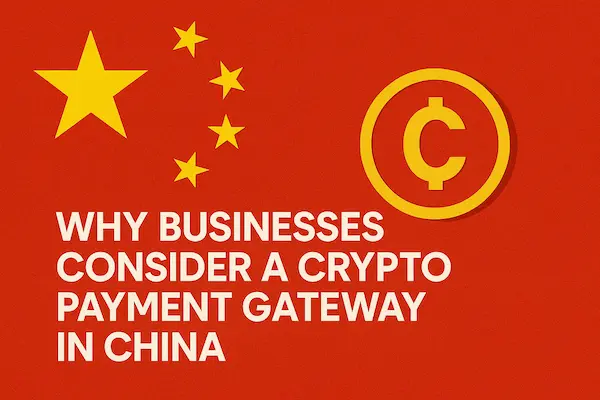
3. Leading Crypto Payment Gateway Providers for China in 2026
While domestic restrictions remain in place, cross-border solutions continue to expand. Several international platforms provide stablecoin settlement, compliance support, and technical integration for merchants. For businesses evaluating a crypto payment gateway in China, the following providers are most relevant in 2026.
1. XaiGate
XaiGate is built with exporters and SMEs in mind. It specializes in USDT and USDC settlements, offers low fees (0.2%-0.5%), and supports integration through API and plugins for Magento, WooCommerce, and PrestaShop. Its focus on compliance-friendly cross-border transactions makes it a strong choice for Chinese companies engaged in global trade.
2. Binance Pay
Binance Pay benefits from Binance’s global network, allowing merchants to accept USDT, BTC, ETH, and BNB. Fees are competitive at 1%, and payments can be processed via QR codes or the Binance app. For Chinese merchants, its main advantage lies in cross-border acceptance, though domestic use remains limited by regulation.
3. Alchemy Pay
Alchemy Pay provides a hybrid solution connecting crypto with fiat systems. It supports stablecoins and major cryptocurrencies, integrates with Shopify, WooCommerce, and offline POS systems, and charges around 1% per transaction. With strong partnerships in Asia, it appeals to cross-border eCommerce merchants.
4. CoinPayments
CoinPayments is one of the oldest crypto gateways, operating globally since 2013. It supports 1,900+ cryptocurrencies, including stablecoins, with fees starting at 0.5%. For Chinese exporters, it offers broad flexibility, though integration can be more complex compared to newer competitors.
5. TripleA
TripleA is a Singapore-based provider licensed under the Monetary Authority of Singapore (MAS). It supports USDT, USDC, BTC, and ETH, with a focus on cross-border B2B payments. Transaction fees average around 1%, and its regulatory clarity makes it attractive for Chinese merchants seeking a compliant crypto payment gateway in China.
Comparison Table: Leading Providers (2026)
| Provider | Support for China | Coins Supported | Integration Options | Fees |
|---|---|---|---|---|
| XaiGate | Cross-border SMEs | BTC, BCH, USDT, USDC, other Stablecoins, + 9800 coins | API, Plugins (WordPress, Magento, Woo, OpenCart, PrestaShop, Shopiffy) | 0.2-0.5% |
| Binance Pay | Global merchants | BTC, ETH, USDT, BNB | QR codes, App | 0.5% |
| Alchemy Pay | Asia eCommerce | BTC, ETH, USDT | Shopify, Woo, POS | 1% |
| CoinPayments | Global exporters | 1,900+ cryptos, stablecoins | API, Plugins | 1% |
| TripleA | Licensed in Singapore | BTC, ETH, USDT, USDC | API, B2B integrations | 1% |
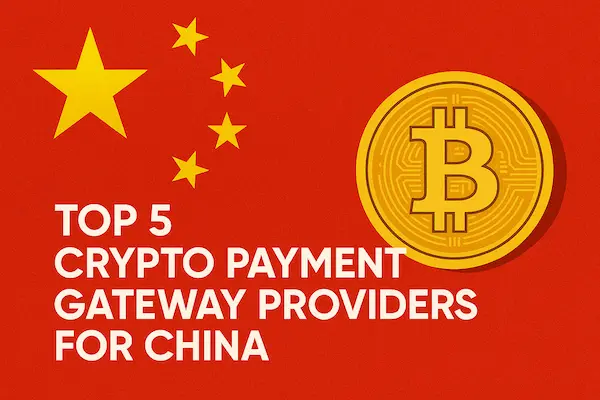
4. Key Challenges for Crypto Payment Gateways in China
Although the demand for cross-border blockchain payments is growing, companies face several obstacles when trying to implement a crypto payment gateway in China. These challenges are not only legal but also operational and market-driven, and businesses must prepare carefully to navigate them.
1. Strict Regulatory Restrictions
China continues to ban domestic crypto trading and retail payments. This means that a crypto payment gateway cannot be used for transactions inside the country. Instead, it is limited to cross-border use cases, which narrows adoption compared to Singapore or Hong Kong.
2. Compliance with AML and KYC Rules
Authorities closely monitor international financial flows. Gateways must meet anti-money laundering (AML) and know-your-customer (KYC) requirements. For smaller merchants, this creates additional paperwork and onboarding hurdles, which can slow adoption.
3. Preference for the Digital Yuan (e-CNY)
The Chinese government promotes the Digital Yuan as the preferred digital payment system. While stablecoins like USDT or USDC are widely used internationally, local regulators will always favor e-CNY in the long run. This puts pressure on businesses that want to use a crypto payment gateway in China but must still consider CBDC adoption.
4. Limited Public Awareness and Trust
Outside of major cities and tech hubs, awareness of stablecoins and crypto payments remains low. Many merchants are hesitant to adopt crypto due to fear of volatility, unclear legality, or lack of technical knowledge. This gap in understanding slows down wider usage.
5. Market and Exchange Rate Volatility
Even stablecoins carry risks linked to liquidity, regulatory scrutiny, or peg stability. If trust in a stablecoin weakens, merchants could face sudden losses. For exporters relying on consistent profit margins, such volatility poses a serious risk when using a crypto payment gateway.
5. Step-by-Step: How Merchants Can Accept Crypto Payments from China
Accepting crypto payments from China requires a careful approach because domestic crypto transactions are banned. However, international merchants and exporters can still serve Chinese customers through cross-border, offshore solutions. Below is a straightforward process to integrate a crypto payment gateway in China safely and effectively.
Step 1: Choose a Global Crypto Gateway (XaiGate Recommended)
The first step is selecting a trusted provider. XaiGate is highly recommended because it specializes in stablecoin payments (USDT, USDC, PYUSD) with low fees, fast settlements, and compliance-friendly infrastructure. Other providers like Binance Pay, Alchemy Pay, or TripleA also operate globally, but XaiGate offers strong API documentation and support tailored for merchants in restricted markets such as China.
Step 2: Enable Stablecoins
Activate stablecoin payment options on your gateway dashboard. USDT and USDC are the most widely used by Chinese traders, cross-border buyers, and international exporters. Stablecoins ensure price stability, which is essential when operating in markets with heavy regulations.
Step 3: Set Up Offshore Settlement
Because Chinese banks do not process crypto, you must direct settlements to offshore accounts. Most businesses choose bank accounts in Singapore, Hong Kong, or Europe to receive fiat after conversion. This offshore setup ensures compliance while enabling smooth cash flow.
Step 4: Integrate API or Plugins
Integrate the chosen gateway into your eCommerce or B2B platform. Use API documentation or plugins for Shopify, WooCommerce, Magento, or PrestaShop. A seamless checkout process allows Chinese clients to pay in stablecoins while merchants securely receive offshore settlements.
Step 5: Maintain Global Compliance Standards
Even though crypto is banned domestically in China, merchants must comply with international AML and FATF guidelines. Keep transaction records, apply KYC/KYB procedures, and prepare for future regulatory shifts, including possible integration of e-CNY with cross-border blockchain networks.
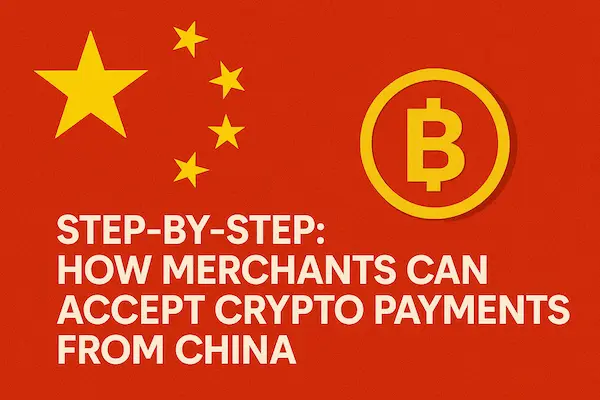
6. Case Studies: Real-World Applications of Crypto Payment Gateway in China
Understanding the opportunities and risks of adopting a crypto payment gateway in China becomes clearer when looking at how businesses are already applying these solutions in practice. The following examples show how exporters, startups, and service providers leverage crypto payments to cut costs, improve speed, and attract international customers.
1. Textile Exporter in Guangzhou
A mid-sized textile company shipping garments to the Middle East used to depend on slow and expensive SWIFT transfers. Fees reached 4% per transaction with settlement delays of up to four days. By integrating XaiGate, the exporter switched to USDT settlements, reducing costs to 0.5% and cutting settlement time to 10 minutes.
2. SaaS Startup in Beijing
A Beijing-based SaaS provider struggled to collect payments from clients in Southeast Asia due to bank restrictions. With Binance Pay, the startup began receiving USDT and BNB quickly and securely. Settlement speed improved by more than 70%, and monthly revenue collection increased by 30%, strengthening cash flow.
3. Tourism Agency in Shanghai
Tourists visiting China often face problems paying with local apps like Alipay or WeChat Pay, which require Chinese bank accounts. A Shanghai travel agency solved this issue by adopting Alchemy Pay to accept USDC from Singaporean visitors. Payments were instantly converted into e-CNY, making the process seamless for both tourists and the agency.
4. Electronics Exporter in Shenzhen
An electronics exporter selling to Latin America faced high remittance costs and capital control issues. By working with TripleA, licensed in Singapore, the exporter started accepting USDC with settlements completed in under an hour. The company could then decide to keep stablecoins or convert them to fiat depending on market conditions, improving treasury management.
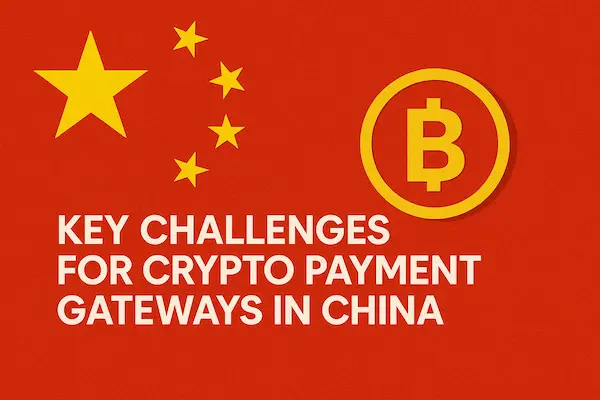
7. Future Outlook: How e-CNY and Stablecoins Will Shape Crypto Payment Gateway in China
The future of digital payments in China will not rely solely on one technology. Instead, it is moving toward a hybrid model that combines the Digital Yuan (e-CNY) with international stablecoins. For businesses, this evolution is critical in deciding how and when to adopt a crypto payment gateway in China.
1. Integration of e-CNY into Cross-Border Payments
The People’s Bank of China has expanded pilot programs for the Digital Yuan, which already processed 1.8 trillion yuan (≈ $250 billion) in test transactions by late 2024. In the coming years, it is expected that e-CNY will be integrated into blockchain-based settlement networks like mBridge, making it easier for exporters and importers to use both CBDC and stablecoins in international trade.
2. Coexistence of Stablecoins and CBDCs
While the government favors e-CNY, global demand for USDT and USDC remains strong, especially for trade with partners in Southeast Asia, the Middle East, and Latin America. Experts predict that instead of replacing stablecoins, China will allow them to coexist with e-CNY under regulated frameworks. This means a crypto payment gateway in China will need to support both forms of digital currency.
3. Expansion of Cross-Border Use Cases
Cross-border eCommerce and B2B transactions are projected to keep growing, with Chinese exporters increasingly turning to blockchain solutions. Between 2026 and 2030, crypto payment gateways are expected to serve not just SMEs but also large enterprises in logistics, manufacturing, and services.
4. Greater Regulatory Clarity by 2030
Although the current environment is restrictive, regulators are signaling a willingness to create more structured guidelines for blockchain-based finance. By 2030, clearer rules could legitimize parts of the crypto payment ecosystem, opening the door for wider adoption of a crypto payment gateway in China.
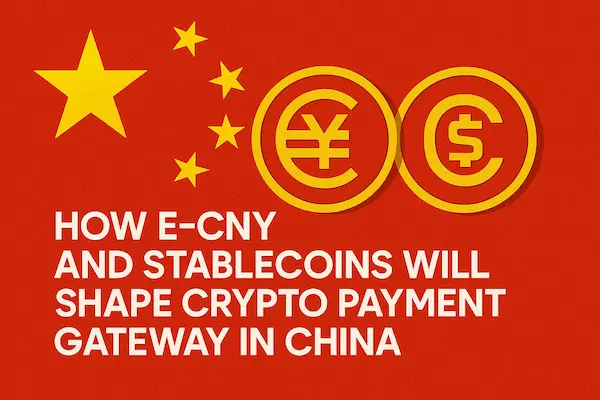
FAQs about Crypto Payment Gateway in China
Below are the most common questions businesses and individuals ask when exploring the use of a crypto payment gateway in China. These FAQs provide clarity on regulations, opportunities, and practical use cases.
1. Is crypto payment legal in China?
Domestic crypto payments are prohibited, but cross-border transactions can be carried out under sandbox pilots and through international providers.
2. Can Chinese merchants legally accept USDT or USDC?
Yes, but only through cross-border payment gateways. Domestic acceptance within mainland China is not allowed.
3. What role does the Digital Yuan (e-CNY) play?
The e-CNY is China’s central bank digital currency, currently in large-scale pilot use. It may eventually integrate with blockchain networks for international trade.
4. Which providers offer reliable services for Chinese businesses?
The leading providers include XaiGate, Binance Pay, Alchemy Pay, CoinPayments, and TripleA, each offering different fee structures and integrations.
5. Are crypto gateways safe for cross-border trade?
Yes, if merchants choose licensed providers and comply with AML/KYC rules. Reputable gateways also offer fraud protection and settlement transparency.
6. What industries benefit most from a crypto payment gateway in China?
Exporters, cross-border eCommerce merchants, SaaS companies, and tourism operators benefit the most due to faster settlements and lower costs.
7. How do transaction fees compare with traditional banking?
Traditional wire transfers can cost 3–6% per transaction, while most crypto gateways charge between 0.2% and 1%, significantly reducing expenses.
8. How fast are settlements with a crypto payment gateway?
Bank transfers may take several days, but crypto payments usually settle in minutes to one hour, depending on the network and provider.
9. What risks should businesses consider?
Key risks include regulatory uncertainty, exchange rate volatility, and dependency on international providers. Merchants must manage these risks through compliance and diversification.
10. What is the long-term outlook for crypto payments in China?
By 2030, experts expect e-CNY and stablecoins to coexist, with greater regulatory clarity and wider adoption of cross-border crypto payment gateways.
Conclusion: The Strategic Future of Crypto Payment Gateway in China
China remains one of the most complex markets for digital assets, yet it also holds some of the largest opportunities. Domestic restrictions mean that crypto is unlikely to replace the Digital Yuan (e-CNY), but in cross-border trade, stablecoins such as USDT and USDC are already proving essential.
By 2026, exporters, SaaS startups, and tourism operators are using a crypto payment gateway in China to cut costs, improve cash flow, and serve international customers more effectively. Looking ahead to 2030, experts expect a hybrid ecosystem, where e-CNY works alongside stablecoins in global commerce. For businesses, this means preparing early is not optional—it is strategic.
Quick Summary Table
| Key Factor | Insight for 2026–2030 |
|---|---|
| Regulations | Domestic ban remains, but cross-border pilots expanding |
| Costs vs. Banking | Crypto fees 0.2–1% vs. 3–6% in SWIFT transfers |
| Settlement Speed | Minutes vs. 2–5 days in traditional banking |
| Leading Providers | XaiGate, Binance Pay, Alchemy Pay, CoinPayments, TripleA |
| Future Trend | e-CNY + stablecoins hybrid system for trade |
If your business is engaged in cross-border trade, eCommerce, or international services, now is the time to act.
Don’t wait until regulations shift—implement a crypto payment gateway in China today to reduce costs, accelerate settlements, and prepare for the future of digital currency.
Start with trusted providers like XaiGate, designed for SMEs and exporters, offering secure stablecoin payments, low fees, and quick integration. Position your company ahead of the curve in the next wave of global digital trade.
For daily updates, subscribe to XAIGATE’s blog!
We may also be found on GitHub, and X (@mxaigate)! Follow us!

